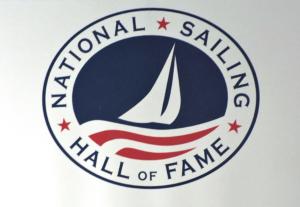 At the foot of Prince George Street in historic Annapolis lies the National Sailing Hall of Fame. It’s in a lovely white house but isn’t marked with any prominent signage.
At the foot of Prince George Street in historic Annapolis lies the National Sailing Hall of Fame. It’s in a lovely white house but isn’t marked with any prominent signage.
“We’re in the development stage of building the museum,” explained the woman on duty who gave her name as Sandy. “We originally had this lot and the lots next door, where the Annapolis Yacht Club is temporarily located. We reconsidered our plans and have rightsized the goal to $10 million. The museum will be built on this site.”
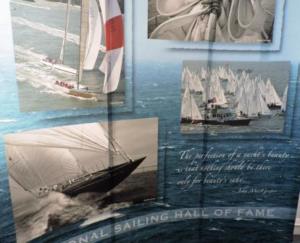 According to the website, “The National Sailing Hall of Fame promotes sailing by preserving America’s sailing legacy and engages the next generation by sharing the benefits, excitement and beauty of sailing.”
According to the website, “The National Sailing Hall of Fame promotes sailing by preserving America’s sailing legacy and engages the next generation by sharing the benefits, excitement and beauty of sailing.”
Sailing for all agesThe vision is straightforward: “We envision an America where people of all ages, backgrounds, and abilities can participate in sailing and fully appreciate the life lessons it offers.” |
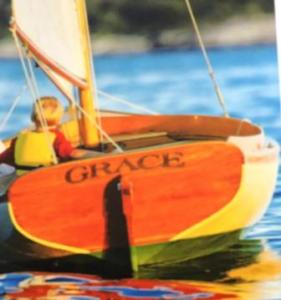 Sandy said, “We provide a lot of staff programming, especially with the STEM program. Our volunteers go into schools to teach sailing through science, technology, engineering and math. Then in the summers we take students out on boats to show them how to sail. We draw local boat owners who volunteer their time. This past summer we started teaching African-American students from Annapolis. Most of the kids live here but have never been out on the water.”
Sandy said, “We provide a lot of staff programming, especially with the STEM program. Our volunteers go into schools to teach sailing through science, technology, engineering and math. Then in the summers we take students out on boats to show them how to sail. We draw local boat owners who volunteer their time. This past summer we started teaching African-American students from Annapolis. Most of the kids live here but have never been out on the water.”
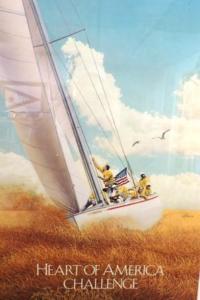 Whenthe United States lost the America’s Cup for the first time in 1983, people were shocked. In Chicago, sailors organized a comeback by encouraging more racing and participation through the “Heart of America Challenge.” The poster is perhaps the most creative piece in the collection.
Whenthe United States lost the America’s Cup for the first time in 1983, people were shocked. In Chicago, sailors organized a comeback by encouraging more racing and participation through the “Heart of America Challenge.” The poster is perhaps the most creative piece in the collection.
Hall of Fame
Sandy said 57 people have been inducted into the Hall of Fame. A promotional flier recounts inductions in San Diego, New Orleans, Detroit, Bay Head, and of course Annapolis. “During the course of their general commentary, football, baseball, basketball, tennis and golf commentators always refer to future Hall of Famers. Sailing now has the same aspiration for young sailors.”
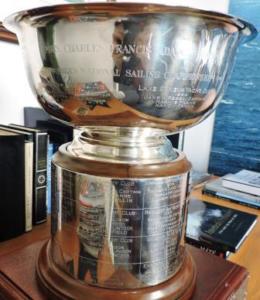 Currently the building has a library upstairs with thousands of books, pamphlets, promotional posters and prints. Sandy said the enterprise began in 2005 and wound up at 67 Prince George in 2010. The biggest thing in the house is the national women’s sailing trophy, which resembles a miniature Stanley Cup.
Currently the building has a library upstairs with thousands of books, pamphlets, promotional posters and prints. Sandy said the enterprise began in 2005 and wound up at 67 Prince George in 2010. The biggest thing in the house is the national women’s sailing trophy, which resembles a miniature Stanley Cup.
Myriad books line shelves that go around all four walls of two rooms, floor to ceiling. They are organized by their donors.
 The Cronkite Collection is typical in that it’s a shelf of books owned by the famed CBS broadcaster. It makes more sense to reorganize the entire floor by a Dewey Decimal system of Sailing, Instruction, Racing, Maintenance, History and so on.
The Cronkite Collection is typical in that it’s a shelf of books owned by the famed CBS broadcaster. It makes more sense to reorganize the entire floor by a Dewey Decimal system of Sailing, Instruction, Racing, Maintenance, History and so on.
The challenge
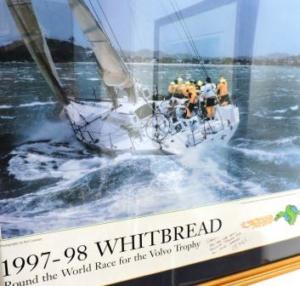 Therein epitomizes the challenge of the Hall of Fame, for sailing is a vast enterprise. At the very top are the world races such as the America’s Cup and the Volvo round the world race (formerly Whitbread). One item displayed is the complete marketing plan for the 2013 America’s Cup, whose genius was to race in San Francisco Bay where thousands of people could watch every day from the shore. Gary Johnson wrote in his “Letter to Larry [Ellison]”: “I was leaving the television broadcast center when a fan from the Midwest approached me with great enthusiasm and yelled out, ‘Because of your television [exposure] and these incredible races, I just bought my first boat.'”
Therein epitomizes the challenge of the Hall of Fame, for sailing is a vast enterprise. At the very top are the world races such as the America’s Cup and the Volvo round the world race (formerly Whitbread). One item displayed is the complete marketing plan for the 2013 America’s Cup, whose genius was to race in San Francisco Bay where thousands of people could watch every day from the shore. Gary Johnson wrote in his “Letter to Larry [Ellison]”: “I was leaving the television broadcast center when a fan from the Midwest approached me with great enthusiasm and yelled out, ‘Because of your television [exposure] and these incredible races, I just bought my first boat.'”
Yet the lesson of exposure seems lost already. The 2017 race will be held in Bermuda, of all places.
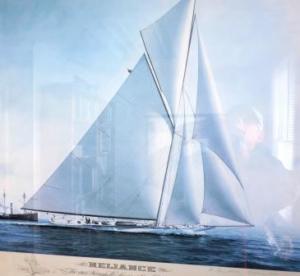 These races epitomize the experience of massive sailing schooners of the 19th century. Smaller versions were used to fish and required multiple sails to gain speed and direction. The big boats are breathtaking for the sheer amount of canvas flying. Reliance is an excellent example.
These races epitomize the experience of massive sailing schooners of the 19th century. Smaller versions were used to fish and required multiple sails to gain speed and direction. The big boats are breathtaking for the sheer amount of canvas flying. Reliance is an excellent example.
Optimist dinghy
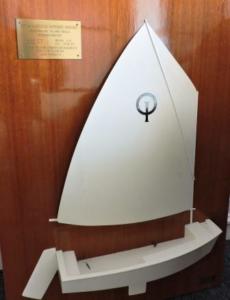 At the other end of the spectrum lies the Optimist dinghy. This is the class of boat that children have learned on for generations. They are hard to point, hard to sail, and tip easily. And people wonder why kids get discouraged. The challenge for the Hall of Fame is to blend the excitement of big boats with that of small boats in hopes of inspiring all ages. The complexity of sailing (nomenclature, physics, costs, etc.) can be discouraging.
At the other end of the spectrum lies the Optimist dinghy. This is the class of boat that children have learned on for generations. They are hard to point, hard to sail, and tip easily. And people wonder why kids get discouraged. The challenge for the Hall of Fame is to blend the excitement of big boats with that of small boats in hopes of inspiring all ages. The complexity of sailing (nomenclature, physics, costs, etc.) can be discouraging.
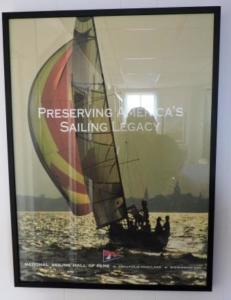 Perhaps the best promotion is to keep it simple. A card stock does this well by summarizing three beliefs of the Hall of Fame. “We believe what you see on the water will change the way you see life on land. We believe that people who don’t sail and missing something. We believe we can change that. Join us.”
Perhaps the best promotion is to keep it simple. A card stock does this well by summarizing three beliefs of the Hall of Fame. “We believe what you see on the water will change the way you see life on land. We believe that people who don’t sail and missing something. We believe we can change that. Join us.”
Let’s go sail
Check rates and pick a day for a sailboat charter. See reviews on Trip Advisor from sailors like you.



